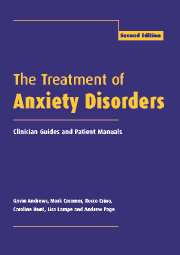Book contents
- Frontmatter
- Contents
- List of authors
- Preface to the second edition
- Abbreviations
- 1 Read me
- 2 General issues in anxiety disorders
- 3 General issues in treatment: Clinician Guide
- 4 Panic disorder and agoraphobia: Syndrome
- 5 Panic disorder and agoraphobia: Treatment
- 6 Panic disorder and agoraphobia: Clinician Guide
- 7 Panic disorder and agoraphobia: Patient Treatment Manual
- 8 Social phobia: Syndrome
- 9 Social phobia: Treatment
- 10 Social phobia: Clinician Guide
- 11 Social phobia: Patient Treatment Manual
- 12 Specific phobias: Syndrome
- 13 Specific phobias: Treatment
- 14 Specific phobias: Clinician Guide
- 15 Specific phobias: Patient Treatment Manual
- 16 Obsessive-compulsive disorder: Syndrome
- 17 Obsessive-compulsive disorder: Treatment
- 18 Obsessive-compulsive disorder: Clinician Guide
- 19 Obsessive-compulsive disorder: Patient Treatment Manual
- 20 Generalized anxiety disorder: Syndrome
- 21 Generalized anxiety disorder: Treatment
- 22 Generalized anxiety disorder: Clinician Guide
- 23 Generalized anxiety disorder: Patient Treatment Manual
- 24 Posttraumatic stress disorder: Syndrome
- 25 Posttraumatic stress disorder: Treatment
- 26 Posttraumatic stress disorder: Clinician Guide
- 27 Posttraumatic stress disorder: Patient Treatment Manual
- 28 Conclusions
- References
- Index
13 - Specific phobias: Treatment
Published online by Cambridge University Press: 05 August 2016
- Frontmatter
- Contents
- List of authors
- Preface to the second edition
- Abbreviations
- 1 Read me
- 2 General issues in anxiety disorders
- 3 General issues in treatment: Clinician Guide
- 4 Panic disorder and agoraphobia: Syndrome
- 5 Panic disorder and agoraphobia: Treatment
- 6 Panic disorder and agoraphobia: Clinician Guide
- 7 Panic disorder and agoraphobia: Patient Treatment Manual
- 8 Social phobia: Syndrome
- 9 Social phobia: Treatment
- 10 Social phobia: Clinician Guide
- 11 Social phobia: Patient Treatment Manual
- 12 Specific phobias: Syndrome
- 13 Specific phobias: Treatment
- 14 Specific phobias: Clinician Guide
- 15 Specific phobias: Patient Treatment Manual
- 16 Obsessive-compulsive disorder: Syndrome
- 17 Obsessive-compulsive disorder: Treatment
- 18 Obsessive-compulsive disorder: Clinician Guide
- 19 Obsessive-compulsive disorder: Patient Treatment Manual
- 20 Generalized anxiety disorder: Syndrome
- 21 Generalized anxiety disorder: Treatment
- 22 Generalized anxiety disorder: Clinician Guide
- 23 Generalized anxiety disorder: Patient Treatment Manual
- 24 Posttraumatic stress disorder: Syndrome
- 25 Posttraumatic stress disorder: Treatment
- 26 Posttraumatic stress disorder: Clinician Guide
- 27 Posttraumatic stress disorder: Patient Treatment Manual
- 28 Conclusions
- References
- Index
Summary
A successful treatment for specific phobias should decrease the fear-driven avoidance behavior. Coupled with reducing the avoidance are two related problems. First, some phobics do not avoid feared situations, but endure them with distressingly high levels of anxiety. More recent etiological accounts have suggested that some specific phobics fear the anxiety (and its imagined consequences) as much as others fear the phobic object (and its imagined consequences). The second difficulty in decreasing avoidance is that specific phobics typically exhibit anticipatory anxiety;either worrying about an inevitable contact with the feared object or situation or worrying about the possibility of contact with what is feared. Therefore, a successful treatment will also reduce the amount of anxiety experienced during exposure and in anticipation thereof. In summary, an effective treatment will reduce (1) the level of anxiety triggered by exposure to feared objects, (2) the level of anticipatory anxiety, and (3) the extent of avoidance.
Nondrug treatments
Nondrug treatments of the specific phobias can be divided into two categories: behavioral and cognitive treatments. Before discussing these empirically-validated treatments, it is worth addressing a treatment that has appeared recently in the literature. Eye Movement Desensitization and Reprocessing (EMDR) was initially developed in the context of PTSD, but it has been applied to specific phobias. Muris and Merckelbach have conducted three controlled trials of EMDR (Muris and Merkelbach, 1997;Muris et al., 1997, 1998). Despite some methodological concerns (Cahill et al., 1999) the strongest conclusions that can be supported from these studies are that exposure is an effective method for reducing self-reported fear and avoidance behavior, EMDR shows no evidence of being able to reduce avoidance behavior and there is occasional support that EMDR reduces selfreported fear. Thus, outside a research context, it would seem negligent to attempt a trial of EMDR for specific phobias before a comprehensive attempt at in vivo exposure has been conducted.
Returning to the behavioral and cognitive treatments, in clinical practice both components are combined to varying degrees. However, in order to evaluate the unique and combined contributions of each, it is useful to discuss the interventions separately.
Behavioral treatments
A learning-based etiological model suggests that treatment should involve extinction or exposure to the feared stimulus in the absence of the feared consequences. Such exposure has been widely demonstrated to be a rapid and effective treatment of specific phobias (Emmelkamp, 1979;O'Brien, 1981; Butler, 1989b).
- Type
- Chapter
- Information
- The Treatment of Anxiety DisordersClinician Guides and Patient Manuals, pp. 271 - 276Publisher: Cambridge University PressPrint publication year: 2002



